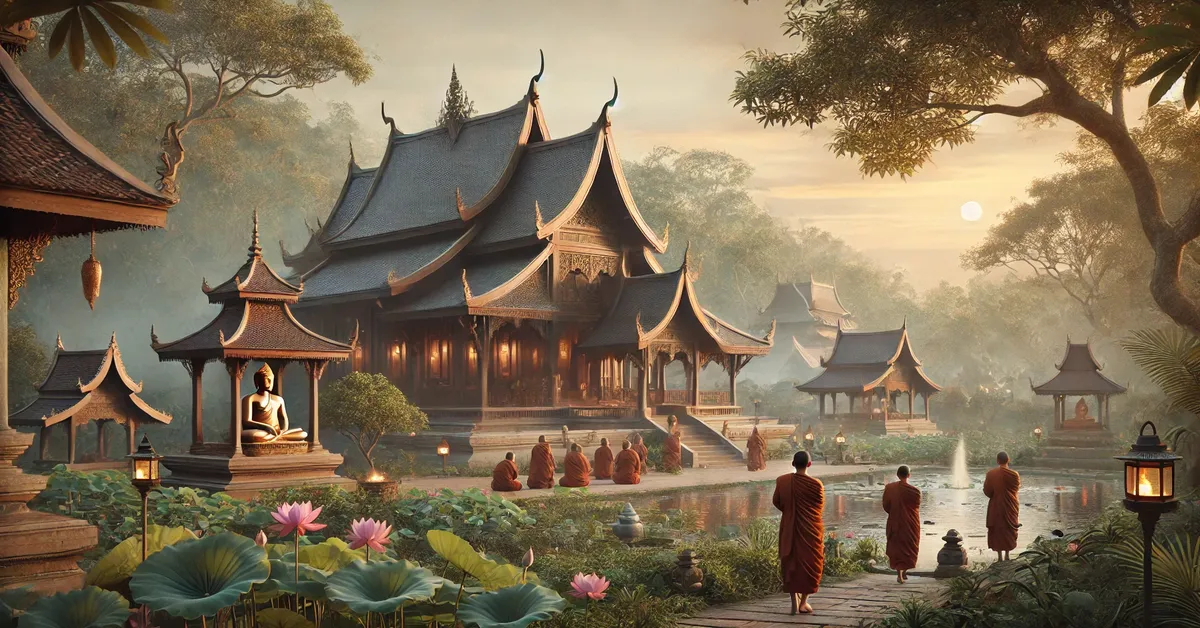Visiting a Buddhist temple can be a deeply enriching experience. Whether you are a spiritual seeker, a curious traveler, or simply interested in exploring new cultures, Buddhist temples offer a serene and welcoming environment that invites reflection, peace, visiting a buddhist temple reviews and learning. From their intricate architecture and sacred rituals to the calm and meditative atmosphere, each temple visit is unique, providing insight into the Buddhist way of life.
In this article, we will explore what you can expect when visiting a Buddhist temple, review some of the most famous temples worldwide, and offer practical tips on temple etiquette and traditions. By the end, you’ll have a comprehensive understanding of the significance of Buddhist temples and how to make the most of your visit.
What to Expect When Visiting a Buddhist Temple
1. A Calming Atmosphere (visiting a buddhist temple reviews)
Buddhist temples are designed to be places of peace and tranquility. Many visitors report feeling an immediate sense of calm upon entering the temple grounds. The serene environment, often surrounded by nature, is meant to encourage reflection and mindfulness. The sound of chanting monks, the gentle waft of incense, and the sight of Buddha statues visiting a buddhist temple reviews create a calming atmosphere that helps to foster an inner sense of peace.
2. Spiritual and Cultural Significance
Buddhist temples are not just places of worship; they are repositories of cultural and spiritual knowledge. They serve as community centers, places for meditation, and even schools for those interested in learning more about Buddhism. Many temples house important relics, sacred texts, and beautiful art that are of significant historical and cultural importance. The teachings of Buddha are reflected in every corner of these temples, from the intricate architecture to the layout of the temple grounds.
3. Diverse Temple Practices
Depending on the country and sect of Buddhism, the temple experience can vary significantly. For example, in Japan, Zen Buddhist temples focus on simplicity and meditation, while Tibetan Buddhist temples emphasize colorful decorations, complex rituals, and offerings. Thai and Sri Lankan temples often have stupas (large dome-shaped structures) containing visiting a buddhist temple reviews relics of the Buddha or revered monks. It’s essential to research the specific temple you plan to visit to better understand its practices and traditions.
Notable Buddhist Temples Around the World
1. Wat Pho, Thailand
Wat Pho, located in Bangkok, is famous for its giant reclining Buddha statue, measuring 46 meters in length. The temple is one of the oldest in Bangkok and serves as a center for traditional Thai massage, which visitors can experience after their temple tour. The beautiful architecture and intricate murals make Wat Pho a must-visit for those exploring Thailand’s rich cultural heritage. Visitors often praise the peaceful ambiance despite the temple’s popularity.
Review Highlight: Many visitors appreciate the historical significance of Wat Pho and the opportunity to witness the grandeur of the reclining Buddha. The temple’s expansive grounds, dotted with stupas and statues, offer plenty of spots for quiet reflection, visiting a buddhist temple reviews away from the crowds.
2. Boudhanath Stupa, Nepal
The Boudhanath Stupa in Kathmandu is one of the largest in the world and is an important pilgrimage site for Tibetan Buddhists. The massive white dome with the all-seeing eyes of Buddha painted at its top is an iconic symbol of Nepal. Visitors can walk around the stupa, spinning prayer wheels and absorbing the spiritual energy that permeates the area. The surrounding neighborhood is home to many monasteries, where you can learn more about Tibetan Buddhism.
Review Highlight: Visitors often mention the sense of devotion and calm that pervades the site. The Boudhanath Stupa is described as a place where time seems to slow down, allowing for deep reflection and connection with the local spiritual traditions.
3. Shwedagon Pagoda, Myanmar
The Shwedagon Pagoda in Yangon is considered one of the most sacred Buddhist sites in Myanmar. The golden stupa, standing 99 meters tall, is believed to house relics of the Buddha, including a strand of his hair. The entire structure is covered in gold leaf, and visitors are visiting a buddhist temple reviews often awed by its beauty, particularly at sunset when the stupa glows against the evening sky. Walking around the pagoda, you will see locals and monks praying and making offerings, adding to the spiritual ambiance.
Review Highlight: Visitors are captivated by the sheer scale and beauty of the Shwedagon Pagoda. Many emphasize the importance of visiting at sunset when the temple’s golden exterior radiates in the fading light, creating a surreal and sacred atmosphere.
4. Jokhang Temple, Tibet
The Jokhang Temple in Lhasa is the most sacred temple in Tibetan Buddhism. It houses the Jowo Rinpoche, a revered statue of the Buddha, and is a major pilgrimage site for Buddhists. The temple’s mix of Tibetan, Indian, and Nepalese architecture is a testament to the cultural exchanges that shaped Tibet’s spiritual landscape. Visitors often note the devotion of pilgrims, who prostrate themselves before the temple as they approach.
Review Highlight: Reviews often mention the powerful spiritual energy of the Jokhang Temple, especially when witnessing the devotion of pilgrims. The temple’s visiting a buddhist temple reviews historical significance and beautiful murals also leave a lasting impression.
5. Senso-ji Temple, Japan
Senso-ji, located in Tokyo, is one of Japan’s oldest and most visited Buddhist temples. The temple is dedicated to Kannon, the goddess of mercy, and its iconic Thunder Gate welcomes millions of visitors each year. The temple’s bustling atmosphere, coupled with traditional rituals and festivals, makes it a fascinating place to experience Japanese Buddhism.
Review Highlight: Visitors often describe Senso-ji as a blend of spirituality and cultural immersion. The temple’s lively atmosphere, especially during festivals, offers a unique insight into the role of Buddhism in Japanese society.
Etiquette and Customs When Visiting a Buddhist Temple
Visiting a Buddhist temple is a respectful and humbling experience. However, there are several customs and rules that visitors should follow to ensure their visit is respectful to the monks, devotees, and the temple itself.
1. Dress Modestly
Most Buddhist temples require visitors to dress modestly. This typically means covering your shoulders and knees. Some temples may provide shawls or sarongs visiting a buddhist temple reviews if your attire doesn’t meet the guidelines, but it’s always best to come prepared. Wearing respectful clothing is seen as a sign of reverence for the sacredness of the site.
2. Remove Shoes Before Entering
Shoes are not allowed inside the temple as a mark of respect. Most temples have designated areas for visitors to leave their shoes. In some temples, it’s also customary to remove hats or head coverings unless they are worn for religious reasons.
3. Be Mindful of Photography
While many temples allow photography in the outer areas, it’s important to be mindful when taking pictures inside the temple, especially near statues of the Buddha. In some temples, photography may be prohibited altogether. Always check with the temple staff or signage to avoid disrespecting the sacred space.
4. Silence and Reflection
Temples are places for meditation and prayer, so maintaining a quiet and respectful demeanor is essential. Avoid loud conversations, and if you are visiting a buddhist temple reviews traveling with children, ensure they understand the importance of maintaining a peaceful atmosphere.
5. Participate in Rituals Respectfully
You may witness or have the opportunity to participate in certain rituals, such as lighting incense, offering flowers, or receiving a blessing from a monk. If you choose to take part, do so with sincerity and respect. Observing without interfering is also perfectly acceptable.
Practical Tips for Visiting Buddhist Temples
1. Check Opening Hours
Temples may have specific visiting hours, especially for tourists. Some temples open early in the morning for ceremonies and prayers, which can be a great time to experience the temple in a more peaceful and less crowded setting.
2. Bring Small Donations
Making a small donation is a common practice when visiting a temple, and it helps support the maintenance of the temple and the monks who live there. You can also donate offerings such as flowers, incense, or candles, which are often available for purchase near the temple.
3. Respect Local Customs
If you’re visiting a temple in a country where Buddhism is the main religion, take the time to learn about the local customs and traditions. Each region may visiting a buddhist temple reviews have specific practices, and understanding them will enhance your experience and show respect to the local culture.
4. Plan for Comfort
Many temples involve walking long distances or climbing steps. Wear comfortable shoes (which you can easily remove), and bring a hat, sunscreen, and water, especially if the temple is located outdoors or in a hot climate.
Conclusion
Visiting a Buddhist temple is an experience that offers both cultural and spiritual insights. Whether you are drawn to the beautiful architecture, the serene atmosphere, or the teachings of Buddhism, each temple visit provides an opportunity for reflection visiting a buddhist temple reviews and growth. By being respectful of the temple’s customs and engaging with the spiritual practices, visitors can gain a deeper understanding of the Buddhist way of life.
FAQs
- What should I wear when visiting a Buddhist temple? You should wear modest clothing that covers your shoulders and knees. Some temples may provide coverings, but it’s best to come prepared.
- Can I take photos inside a Buddhist temple? It depends on the temple. Some allow photography in certain areas, but it’s important to check for signs or ask temple staff before taking pictures.
- Is there an entrance fee for visiting Buddhist temples? Some temples charge a small entrance fee, while others rely on donations. It’s always a good idea to bring cash for donations or entrance fees.
- Can I participate in rituals if I’m not Buddhist? Yes, visitors are often welcome to participate in rituals such as lighting incense or visiting a buddhist temple reviews offering flowers, but it’s important to do so respectfully.
- Are Buddhist temples only for meditation and prayer? While temples are primarily places for meditation and prayer, they also serve as community centers, schools, and cultural heritage sites, offering a range of activities.
- What is the best time to visit a Buddhist temple? Early morning is often the best time to visit, as it’s quieter and you may have the opportunity to witness visiting a buddhist temple reviews daily prayers or rituals.








